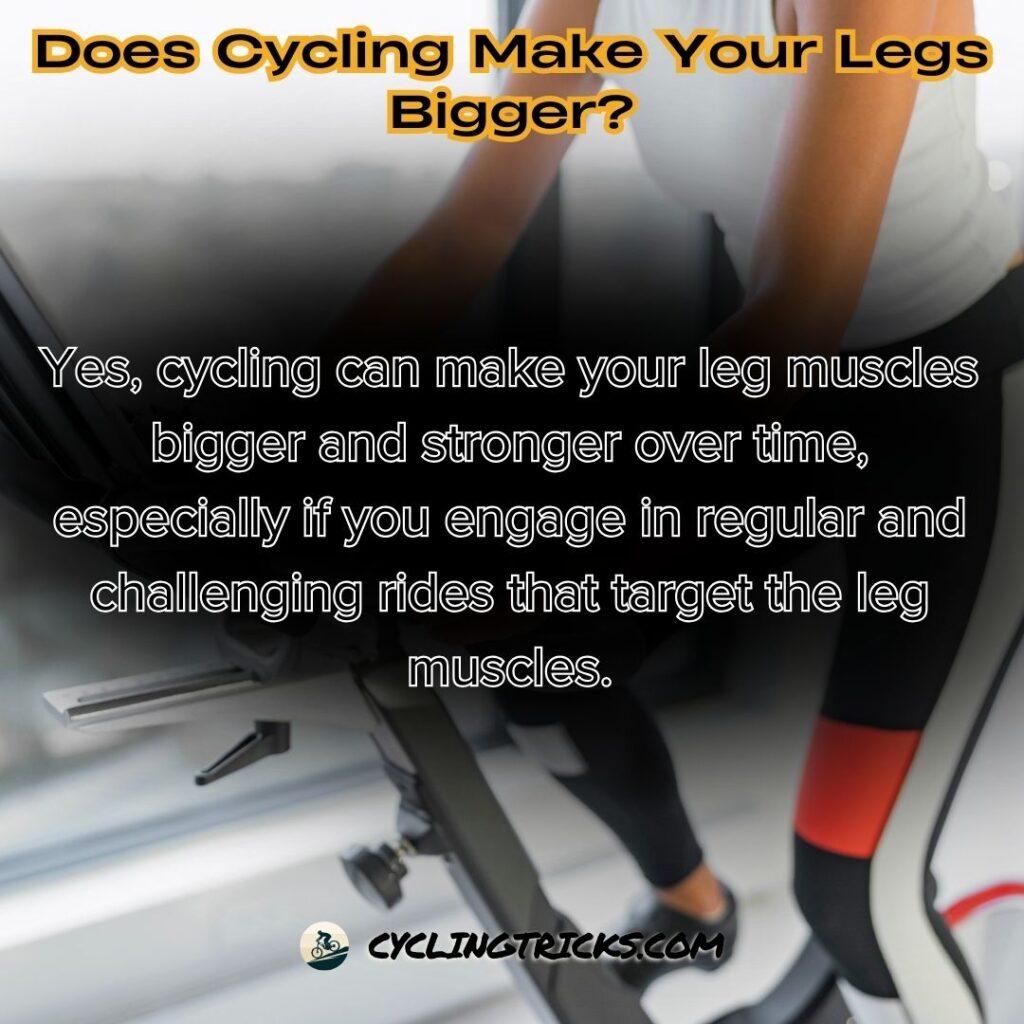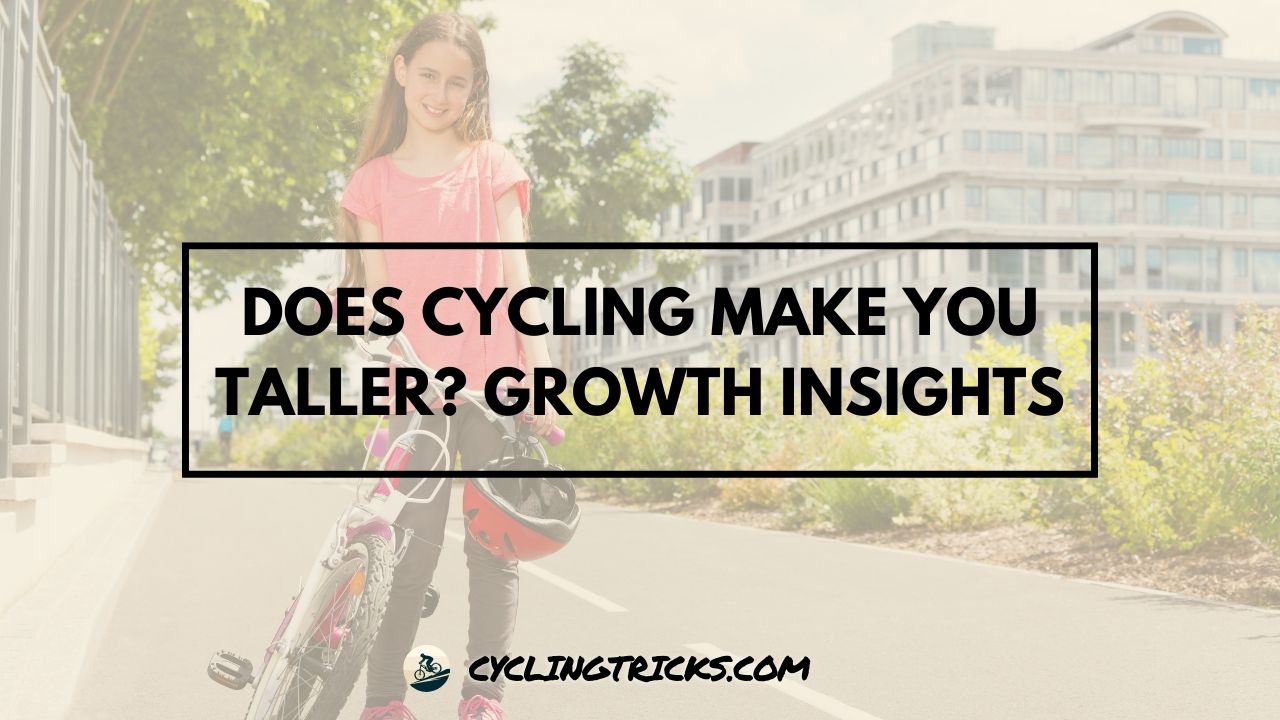Did you know that cycling is not only a popular recreational activity but also a great form of exercise? If you’ve ever wondered that does cycling make your legs bigger then you’re not alone. This question has intrigued fitness enthusiasts and cyclists alike.
In a study conducted by Harvard Medical School, researchers found that regular cycling can indeed contribute to leg muscle growth. The repetitive motion of pedaling engages the major muscle groups in your legs, leading to strength development and potential size increase over time.
So, let’s dive into the details and uncover the truth about leg muscle growth through cycling. I will provide expert insights and explain the science behind how cycling can impact the size of your legs.
Key Takeaways:
- Cycling can contribute to leg muscle growth and potentially make your legs bigger.
- The repetitive motion of pedaling engages major leg muscle groups, promoting strength development.
- The extent of leg size increase may vary based on factors such as genetics, training intensity, and nutrition.
- Cycling offers numerous benefits for leg development, targeting specific leg muscles.
- Incorporating cycling into your fitness routine can be a valuable tool for developing bigger and stronger legs.
Does Cycling Make Your Legs Bigger?
Yes, cycling can make your leg muscles bigger and stronger over time, especially if you engage in regular and challenging rides that target the leg muscles.

The Science Behind Leg Muscle Growth
To understand whether cycling can make your legs bigger, it’s important to grasp the science behind leg muscle growth.
In this section, I will explain the concept of hypertrophy and how it relates to cycling. Let’s delve into how cycling can stimulate muscle growth in your legs.
“Hypertrophy is the process of muscle growth in response to increased demand or stress placed on the muscle fibers. It occurs when the muscle fibers undergo microscopic damage during exercise and then repair themselves, resulting in larger and stronger muscles,”- Dr. Laura Jones, Sports Scientist
Cycling is a highly effective form of exercise for promoting leg muscle hypertrophy. When you cycle, the repetitive motion of pedaling engages several major muscles in your legs, including the quadriceps, hamstrings, and calf muscles. The resistance applied through pedaling creates stress on these muscle fibers, leading to microtears and subsequent repair.
As the muscles repair themselves, they adapt to the increased demand by becoming stronger and larger. Over time, consistent cycling workouts can lead to significant leg muscle growth, resulting in bigger and more defined legs.
It’s worth noting that the degree of hypertrophy from cycling will vary depending on various factors, including genetics, training intensity, and nutrition. Some individuals may naturally experience more significant muscle growth compared to others.
However, incorporating cycling into your fitness routine can undoubtedly contribute to building stronger and more muscular legs.
The Benefits of Cycling for Leg Development
When it comes to leg development, cycling has numerous advantages that go beyond just building strength.
In this section, I will dive into the benefits of cycling as a form of exercise for your legs and provide insights into how it can contribute to your leg muscle growth.
Here are the ten benefits of cycling for leg development:
- Strengthening leg muscles
- Improved muscle tone
- Increased endurance
- Enhanced agility
- Better balance and coordination
- Reduced risk of injury
- Improved bone density
- Enhanced circulation in the legs
- Greater power and explosiveness
- Improved overall lower body strength
Let’s learn about a few of them.
1. Targeted Leg Muscles
Cycling is a fantastic way to engage and work your leg muscles. Whether you’re pedaling uphill, powering through sprints, or maintaining a steady pace, you’ll be actively working your quadriceps, hamstrings, calves, and glutes. These are the key muscles involved in pushing the pedals and propelling you forward.
“Cycling not only targets the major leg muscles but also engages your core, helping improve overall stability and balance.” – Dr. Emma Watson, Sports Medicine Specialist
2. Low-Impact Workout
One of the greatest benefits of cycling for leg development is that it is a low-impact workout. Unlike high-impact activities like running or jumping, cycling puts less stress on your joints, reducing the risk of injury. This means you can push yourself harder during your leg workouts without worrying about straining your knees or ankles.
3. Cardiovascular Fitness
While primarily focusing on leg development, cycling also gets your heart pumping and provides an excellent cardiovascular workout. Regular cycling sessions help improve your cardiovascular fitness, increase your stamina, and enhance your overall endurance.
4. Customizable Intensity
Whether you’re a beginner or a seasoned cyclist, you have the flexibility to adjust the intensity of your leg workout. By changing gears, adjusting resistance levels, or increasing your speed, you can customize your cycling routine to meet your fitness goals and challenge yourself along the way.
5. Outdoors and Fresh Air
Another wonderful advantage of cycling is that it allows you to get out of the gym and enjoy the outdoors. Breathing in fresh air and soaking up vitamin D from the sun can boost your mood and enhance your overall well-being. So, why not make your leg workouts more enjoyable by exploring scenic routes or cycling through nature?
6. Functional Leg Strength
Cycling not only helps you develop muscular legs but also improves your functional leg strength. The strength and power generated during cycling can be transferred to other activities, such as running, hiking, or even everyday tasks like climbing stairs. So, by cycling regularly, you’re building leg strength that goes beyond the bike.
7. Mental Health Benefits
Finally, let’s not forget the mental health benefits of cycling. Engaging in regular exercise, including cycling, can help reduce stress, boost your mood, and improve your overall mental well-being. So, while you’re working on your leg development, you’re also taking care of your mental health.
To maximize your leg workout while cycling, consider incorporating interval training, hill climbs, and sprints into your sessions. These variations can help you challenge your leg muscles further and stimulate growth. Remember to maintain proper form, adjust your bike fit, and listen to your body to prevent any unnecessary strain or injuries.
Now that we’ve explored the benefits of cycling for leg development, let’s move to the last part.
Conclusion
In conclusion to the great question: ‘Does Cycling Make Your Legs Bigger’, cycling is a fantastic way to achieve bigger and stronger legs. Through the science of hypertrophy and targeted leg workouts during cycling, you can see significant improvements in leg muscle growth.
While the extent of leg size increase will vary depending on factors such as genetics, training intensity, and nutrition, incorporating cycling into your fitness routine can be a valuable tool for developing the legs of your dreams.
When you cycle, you engage multiple muscles in your legs, including the quadriceps, hamstrings, and calf muscles. The repetitive motion of pedaling helps to strengthen and tone these muscle groups, resulting in enhanced leg strength and definition. Additionally, cycling is a low-impact form of exercise, making it suitable for individuals of all fitness levels.
To optimize your leg muscle growth through cycling, it’s important to vary your training intensity and duration. Incorporate intervals, Hill training, and resistance work into your rides to challenge your muscles and promote further development. Pair your cycling routine with a well-balanced diet rich in protein, carbohydrates, and essential nutrients to provide your muscles with the fuel they need to grow.
Cycling not only offers physical benefits but also provides an enjoyable and accessible way to stay active. Whether you prefer outdoor cycling or indoor stationary biking, the key is to make it a regular part of your fitness regimen.
So hop on your bike, hit the road or join a local cycling class, and pedal your way to bigger and stronger legs!









